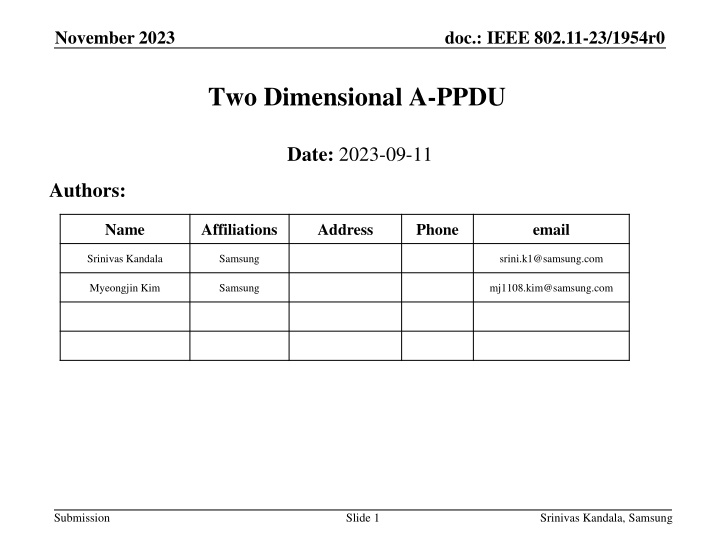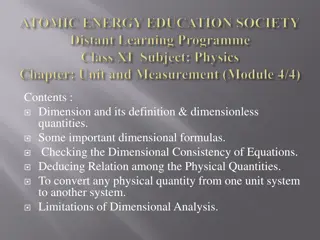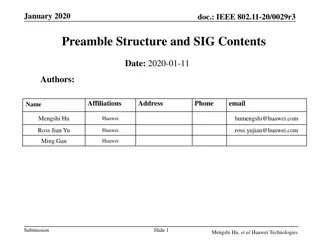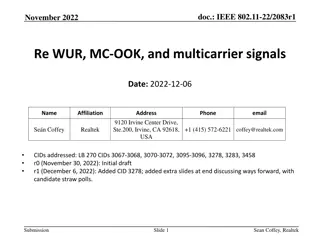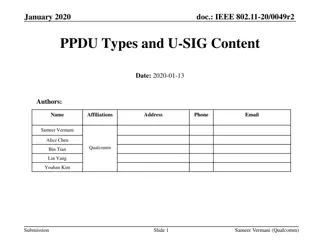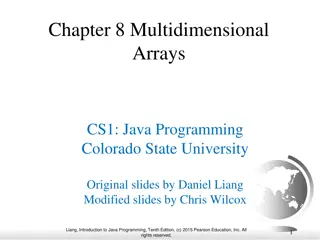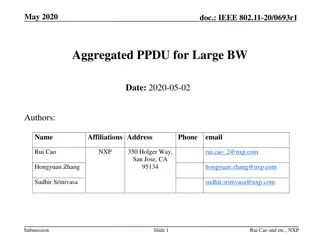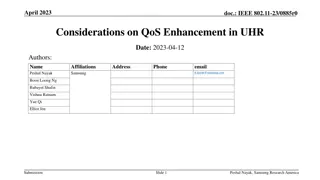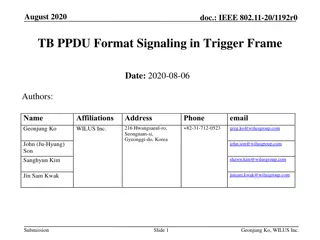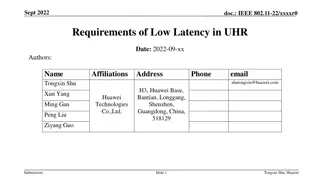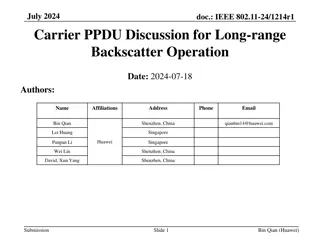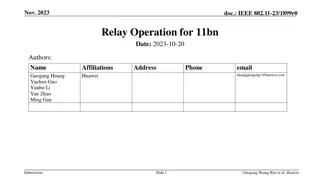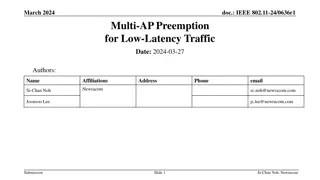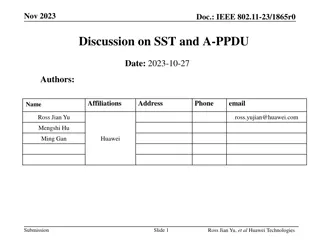Two-Dimensional A-PPDU for Low Latency in UHR Networks
This document discusses the proposed two-dimensional (2D) A-PPDU as a solution for supporting low-latency applications in UHR networks. It delves into the details of 2D A-PPDU for downlink, focusing on the ability to insert PPDUs within a PPDU, aiming to reduce latency in UHR environments by enhancing scheduling flexibility and efficiency.
Download Presentation

Please find below an Image/Link to download the presentation.
The content on the website is provided AS IS for your information and personal use only. It may not be sold, licensed, or shared on other websites without obtaining consent from the author.If you encounter any issues during the download, it is possible that the publisher has removed the file from their server.
You are allowed to download the files provided on this website for personal or commercial use, subject to the condition that they are used lawfully. All files are the property of their respective owners.
The content on the website is provided AS IS for your information and personal use only. It may not be sold, licensed, or shared on other websites without obtaining consent from the author.
E N D
Presentation Transcript
November 2023 doc.: IEEE 802.11-23/1954r0 Two Dimensional A-PPDU Date: 2023-09-11 Authors: Name Affiliations Address Phone email Srinivas Kandala Samsung srini.k1@samsung.com Myeongjin Kim Samsung mj1108.kim@samsung.com Submission Slide 1 Srinivas Kandala, Samsung
November 2023 doc.: IEEE 802.11-23/1954r0 Introduction One of the main objectives in UHR is low latency as described in UHR proposed PAR document [1]. Various latency reduction technologies were introduced in many UHR contributions [2-9]. We briefly proposed two dimensional (2D) A-PPDU in [2] as one of solutions to support low latency application. In this contribution, we discuss 2D A-PPDU for downlink in more detail, with the ability of inserting PPDUs in the middle of a PPDU. Submission Slide 2 Srinivas Kandala, Samsung
November 2023 doc.: IEEE 802.11-23/1954r0 Recap: FD A-PPDU In [3], forward compatible OFDMA was proposed. Multiplexing between different generations of 802.11 PPDUs in frequency domain To improve scheduling flexibility and efficiency In [4], aggregated PPDU for large BW was proposed. Multiplexing between different BW capable STAs in a PPDU in frequency domain Aggregated PPDU PPDU-3 80MHz PPDU-2 80MHz 160MHz PPDU-1 Submission Slide 3 Srinivas Kandala, Samsung
November 2023 doc.: IEEE 802.11-23/1954r0 Recap: Requirements for FD A-PPDU Transparent to legacy STAs PHY OFDM numerology including symbol duration shall be aligned EHT MU PPDU + HE MU PPDU EHT TB PPDU + HE TB PPDU UHR PPDUs (TBD) AP can align these using explicit signaling, such as Number of EHT-SIG Symbols , Number of EHT-LTF Symbols , GI+LTF Size , SIG design to support frequency domain multiplexing of different PPDUs Per 80 MHz U-SIG, EHT-SIG and UHR-SIG HE PPDU shall be 160 MHz, otherwise HE STA may decode wrong L-Length EHT and EHT+ PPDU multiplexing, there is no such restriction as long as it is 80MHz granularity MAC Trigger frame design to support frequency domain multiplexing of different PPDUs Refer Trigger frame design SST operation together with TWT Submission Slide 4 Srinivas Kandala, Samsung
November 2023 doc.: IEEE 802.11-23/1954r0 Recap: Pre-emptible PPDU Aggregation (1/2) In [5], pre-emptible PPDU aggregation was proposed: Multiplexing between different PPDUs in time domain To improve latency for time sensitive MSDUs Detail mechanism is as follows: The transmitter can end the ongoing PPDU after the nearest slot with a PPDU end marker, and then send latency-sensitive traffic within the TXOP. The PPDU end marker could be a rotation of L-LTF or some other predefined sequences. Examples, When no latency sensitive traffic arrived When latency sensitive traffic arrived Submission Slide 5 Srinivas Kandala, Samsung
November 2023 doc.: IEEE 802.11-23/1954r0 Recap: Pre-emptible PPDU Aggregation (2/2) [6] proposes: TXOP preemption indication that indicates if preemption is allowed Time gap preemption indication will signal if preemption is allowed after a gap period. Mechanism provides flexibility for both UL and DL to be able to transmit low-latency frames amidst a TXOP. Breaks the TXOP into multiple PPDUs, which increases the overhead. [7] enhances the basic concepts in [6] after considering some of its limitations. [8] proposes the indication of low latency indication frame amidst an on-going TB PPDU transmission through a pre-agreed signal. [9] builds on [6] on preemption coordination, channel access and resource allocation. Submission Slide 6 Srinivas Kandala, Samsung
November 2023 doc.: IEEE 802.11-23/1954r0 Recap: 11ay A-PPDU In section 28.3.2.2 of [10], EDMG A-PPDU is defined as follows Only to a single user and shall not be transmitted to multiple users. Each subsequent PPDU includes EDMG Header A and Data field only. Actual A-PPDU duration is unknown at the time of L-Header transmission. Each EDMG-Header-A includes PSDU length and Additional EDMG PPDU subfield. It seems A-PPDU is to same user as there is no EDMG-CEF for the subsequent PPDUs. Submission Slide 7 Srinivas Kandala, Samsung
November 2023 doc.: IEEE 802.11-23/1954r0 Two Dimensional A-PPDU (1/5) Requirement of inserted PPDU for latency sensitive MSDUs Transparent to legacy STA including 11be R1 STA We want to transmit latency sensitive MSDU on on-going PPDU including FD A-PPDU as much as possible so that we can reduce latency. Using only necessary subchannel(s). Entire 320 MHz PPDU is quite wasteful given the size of latency sensitive traffic is typically small. Considering these requirements, we propose two dimensional (2D) A-PPDU as the following example. Inserted at predetermined location Traffic arrives Aggregated PPDU Inserted PPDU (Latency Sensitive PSDU) 80MHz PPDU-3 80MHz PPDU-2 160MHz PPDU-1 Submission Slide 8 Srinivas Kandala, Samsung
November 2023 doc.: IEEE 802.11-23/1954r0 Two Dimensional A-PPDU (2/5) Another example is within one DL OFDMA MU PPDU 20MHz RU 1 Normal OFDMA 20MHz RU 2 40MHz RU 3 Inserted at predetermined location Traffic arrives Inserted PSDU (Latency Sensitive PSDU) 20MHz RU 1 2D OFDMA 20MHz RU 2 40MHz RU 3 Submission Slide 9 Srinivas Kandala, Samsung
November 2023 doc.: IEEE 802.11-23/1954r0 Two Dimensional A-PPDU (3/5) Can we insert latency sensitive MSDU on going PPDU without any legacy problem? We shall ensure that there is no impact on operation of the original PPDU receiver. Shall be no change in original PPDU or RU reception procedure. Entire PPDU shall be as indicated by the L-Length. ACK or BA and other procedure followed by a PPDU shall remain same. The original PPDU recipient can send ACK/BA as instructed. Data portion of inserted PPDU will be failed. Already happens in IEEE 802.11 system, e.g. by OBSS interference. UHR STA may detect the start of inserted PPDU and stop decoding until the end of the inserted PPDU. ACK/BA for latency sensitive PPDU can be multiplexed using MU-BAR included separately in the inserted PPDU (Need some empty resource in the MU-BAR in the original PPDU) Or ACK/BA for latency sensitive PPDU can be set to delayed ACK Submission Slide 10 Srinivas Kandala, Samsung
November 2023 doc.: IEEE 802.11-23/1954r0 Two Dimensional A-PPDU (4/5) High level design criteria Inserted PPDU start indication Time-domain (auto/cross) correlation method may not work unless we process only the potential subchannel. Thus, we can consider indicating it using frequency-domain method. E.g. by two repeated LTFs and CRC of SIG. Predetermined start time In order to reduce complexity at latency sensitive MSDU receiver, we want to use slot based start time. For example, we can define a fixed number of OFDM symbol for a potential start of TD PPDU. Potential indication of existence of inserted PPDU We can also include potential inclusion of inserted PPDU in SIG field of original UHR PPDU. It is possible to insert PPDU in UHR or EHT or HE or even VHT/HT/non-HT PPDU . Submission Slide 11 Srinivas Kandala, Samsung
November 2023 doc.: IEEE 802.11-23/1954r0 Two Dimensional A-PPDU (5/5) Structure DATA LTF SIG Bandwidth To simplify receiver of latency sensitive MSDU receiver, we want to limit maximum bandwidth to 80 MHz, so, potential bandwidth can be 20/40/60/80 MHz. Should include predetermined 20 MHz, e.g. primary 20 MHz. OFDMA May enable OFDMA within inserted PPDU with limited resource sizes, e.g. 242- tone RU, 484-tone RU, 484+242-tone MRU, 996-tone RU UHR LTF and SIG (Header) can be served as start indication. Number of symbol for UHR LTF should be fixed, e.g. 2 Number of symbol for SIG should be fixed, e.g. 1 Note: numerology for UHR LTF and SIG should be same as the original data symbol numerology. Submission Slide 12 Srinivas Kandala, Samsung
November 2023 doc.: IEEE 802.11-23/1954r0 Header of Inserted PPDU in Two Dimensional A-PPDU LTF Latency sensitive STA may check existence of UHR LTF in the inserted PPDU. No beamforming Single stream LTF Repeated single stream UHR LTF to enable easy LTF detection as well as CFO/CPE correction SIG A receiver can confirm existence of inserted PPDU using CRC in the SIG . SIG can be encoded within 20 MHz bandwidth of the inserted PPDU, and duplicated for different 20 MHz within the bandwidth of inserted PPDU. The following fields can be included in SIG. PHY Version Identifier LDPC Extra Symbol Segment Pre-FEC Padding Factor PE Disambiguity RU Allocation subfield: This tells BW and puncturing information of inserted PPDU. Submission Slide 13 Srinivas Kandala, Samsung
November 2023 doc.: IEEE 802.11-23/1954r0 Example of 2D A-PPDU Structure Potential Start Position Potential Start Position Potential Start Position Preamble ACK-3 Header (&4) 80MHz PPDU-3 Inserted PPDU-4 Aggregated PPDU Preamble 80MHz ACK2 PPDU-2 Preamble ACK1 160MHz PPDU-1 L-Length Submission Slide 14 Srinivas Kandala, Samsung
November 2023 doc.: IEEE 802.11-23/1954r0 Summary and Conclusions Introduced the details of two dimensional PPDU, where RUs are not only assigned in frequency domain but also in time domain for downlink transmissions to improve latency for time sensitive MSDU. Having the ability for a STA to access an inserted PPDU in the middle of PPDU would enable transmission of late-arriving low- latency MSDUs to be transmitted in a timely manner. Submission Slide 15 Srinivas Kandala, Samsung
November 2023 doc.: IEEE 802.11-23/1954r0 Straw Poll Are you in favor of supporting the concept of two dimensional PPDUs for downlink transmissions in TGbn? Yes: No: Abstain: Submission Slide 16 Srinivas Kandala, Samsung
November 2023 doc.: IEEE 802.11-23/1954r0 References [1] 11-23/0480r3, UHR Proposed PAR [2] 11-22/1393r0, Latency Reduction Scheme for UHR [3] 11-20/674r3, Forward Compatible OFDMA [4] 11-20/693r1, Aggregated PPDU for Large BW [5] 11-21/670r0, Further Improve Latency Performance in 11be [6] 11-23/1229r1, Preemption for low latency application (Follow up) [7] 11-23/1174r0, TXOP preemption follow up [8] 11-23/1194r0, Overlapped indication to support preemption [9] 11-23/1242r1, Considerations on Inter-PPDU based Preemption Scheme [10] Draft P802.11ay_D5.0 Submission Slide 17 Srinivas Kandala, Samsung
